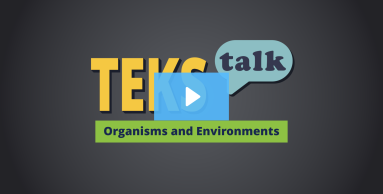- Science
- Grade 2
- Organisms and environments
Science.2.12.A
describe how the physical characteristics of environments, including the amount of rainfall, support plants and animals within an ecosystem;

Knowledge and Skills Statement
Ask students to design a terrarium that would provide a good habitat for a specific plant or animal. Students should determine the amount of light, heat, and moisture the plant or animal needs to survive. They should also consider whether the organism needs shelter and, if so, what kind.
In a short paragraph, students should explain how their chosen organism would get access to those resources in their natural ecosystem. Student responses should indicate that students recognize that different organisms have different needs and that their needs are typically met within their natural environment. For example, a student might design a terrarium for a leopard gecko and explain that a leopard gecko thrives in a desert ecosystem with high heat, low rainfall, and a rocky or sandy ground. They also find places to hide like rocky crevices in the desert to cool down or avoid predators. A plant example students could discuss is the vanilla orchid. A terrarium designed to house a vanilla orchid would require bright, indirect light to simulate the light a vanilla orchid would get by growing part way up a tree and a consistently warm and humid environment that simulates frequent rain. Vanilla orchids are native to rainforests and these conditions help them thrive in that ecosystem.
The further explanation is designed to be a resource for educators that helps them better understand the topic their students are learning. Further explanations may be written at a more complex level than would be expected for students at the grade level.
The environment is described as the surrounding conditions in which an organism lives. This includes all the physical, chemical, and biological factors like air, water, soil, weather, and climate that affect the life and development of the living organisms within it.
An ecosystem, on the other hand, is more specific. It describes multiple populations (a community) of living organisms (plants, animals, and microbes) interacting with each other and their non-living surroundings in a specific area. This system includes both the biotic (living) and abiotic (non-living) components and the interactions between them.
The terms biotic and abiotic factors are taught in grade 5. At this grade level, the conditions and objects surrounding an organism are taught as living (or once-living) and non-living factors.
Research
"Wilcox, Jesse, and Abby Rose. “Visualizing Habitats: Using Visual Data to Help Kindergarteners Model Relationships Between Living Things and the Places They Live.” Science and Children 60, no.1 (2022):26–31.
www.nsta.org/science-and-children/science-and-children-septemberoctober-2022/visualizing-habitats."
Summary: Students in this article observe pictures of living things and different environments and match the living things to their environments. The article explains a project that helps students understand visual data and draw conclusions as to why certain plants and animals live in their specific environments. Teachers can make observations and ask questions during this time to assess students' current knowledge of the subject. Small groups are then each assigned a different habitat with pictures, books, and illustrations to help them understand the needs of the animals in that habitat. Teachers should ask questions about each habitat and encourage students to consider each area's temperature, rainfall, and landscape. Many students could make conclusions about how each environment met the needs of the things that lived there, like deer needing a lot of grass to eat or trees needing a lot of rain. Students can create their own model habitats with the animals and plants that should live there.
